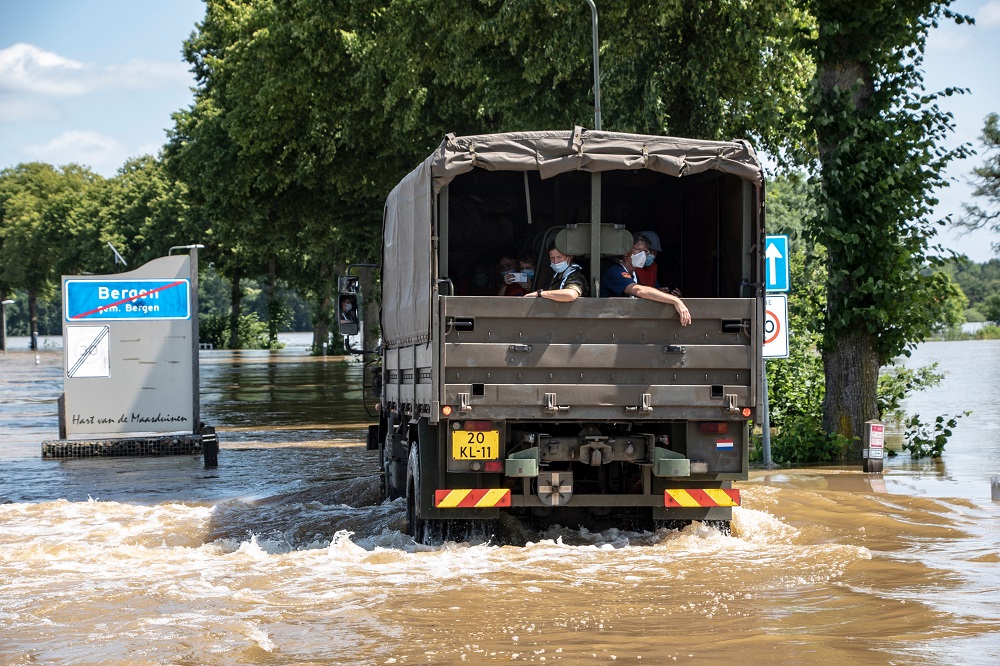The Netherlands should be better prepared for severe weather
A new government coalition brings new opportunities to make the Netherlands safer as we are facing scenarios we could not dream about. While we argue over large-scale climate investments for 2050, we forget to prepare for the weather risks of today and tomorrow. Meaning the Netherlands is only moderately prepared for extreme weather.
By Jeroen Warner en Sandra Megens
Two years ago, it rained improbably hard over the Meuse and Geul rivers for three days, flooding Valkenburg and forcing the evacuation of the Maastricht district of Randwyck (Wyck), which hardly anyone there saw coming. Fortunately, it was not nearly as disastrous as in Belgium and Germany, where dozens of people died in sudden flood events; even there the weather forecasts were wrong. Around May this year, we had five consecutive weeks without rain – a “drought period” countries like India and South Africa would laugh about, but which was unprecedented in the Netherlands.
The impact of El Niño on the weather: Prepare yourself for new temperature records
The bad news is that we will have much more to endure. An El Niño is a temperature fluctuation in the Pacific Gulf Stream that often occurs in December. Every two to seven years, it wells up in the middle of the ocean, then affects the temperature of the air above it and has great impact on global weather effects. A strong Niño can improve fishing and agricultural yields, but it can also damage the global economy, costing tens of billions of dollars as mudslides, forest fires, floods and drought extremes lead to crop failures and massive damage. Well, everything indicates that El Niño came early this year; the United Nations weather service, WMO, states that we are already facing a strong El Niño and that we must count on new temperature records.
You often only see the effects of a Niño in the following year. They will not directly lead to different weather, but its effects do increase the chance of an extremely wet spring season in 2024. This gives food for thought, because even when the atmosphere only gets a small push, we are already in turmoil. Why are we so badly prepared for weather extremes?
First, the Netherlands is situated in a quiet corner of the world, without tsunamis, volcanic eruptions, super cyclones or mudslides. But mind you, we are the victims of our own success. After all, we have our own disaster risks under control: we have built dikes and sea walls to prevent floods from rivers and the sea. As a result, we do not have a disaster culture; we rely on the government to protect us and come to our rescue when things go wrong. When we drew up our new Delta plans, we assumed that with our superior technology and planning we could build houses wherever we wanted: even way below sea level. That may have been a reckless move.
A disaster plan for the Netherlands
By focusing on technical prevention measures, we still lag behind the rest of the world in our disaster thinking. Take the United Nations. This organization has an integrated approach in the form of a disaster cycle: prevention, mitigation, response and recovery. Such a cyclical approach gives credit to the fact that disaster situations do not disappear but keep coming back (and more often). It also makes use of a broader range of tools than just infrastructure: insurance, disaster communications, regular drills, evacuation, and certainly disaster-resistant (rebuilding) plans.
Therefore, please let us stop wanting to live, work and recreate irresponsibly close to the water and in the floodplains and building new residential areas in “bathtubs”. These ideas go back some 25 years, when Minister of Spatial Planning Jan Pronk and his civil servants considered the layout of the Netherlands in the Fifth Memorandum Plus. The ministry wanted citizens to go and live on higher grounds. After the high waters of 1993 and 1995, building in the floodplains was already prohibited – a decision which was again turned around in 2005 under Prime Minister Balkenende,
Weather extremes do not need to turn into disasters if we are all well prepared. It is not the climate itself but poor precaution and vulnerability that costs lives. To prevent future disasters, we will need more social awareness and support than the occasional siren or push message from NLAlert.
A flood-prone city like Dordrecht already communicates openly with citizens about evacuating during high water, but many other municipalities are reluctant. Volunteers from De Zonnebloem, an NGO helping people with physical impairments, are committed to ensuring that vulnerable fellow human beings have enough to drink and stay cool during heat waves, thus reducing excess mortality. Very nice, but the national heat plan was not put into effect during the sweltering month of June. Safety regions would prefer to prevent people from barbecuing in green areas, causing forest fires, and water authorities are going to involve citizens more in precautionary measures. What is still lacking is a coherent national policy to face a new reality. The next government can start making policy straight away, instead of waiting for disaster to strike.

